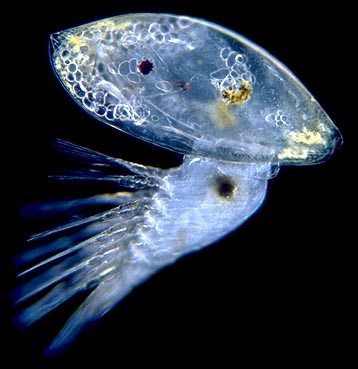Most parasites are really, really small. Especially the ones that mess with brains - they tend to be able to fit in them. But not all parasites that can do some fun jedi mind tricks are so itsy-bitsy. Take, for example, the Rhizocephalans - the parasitic barnacles.
 Yes, I did just say parasitic barnacle. Although you probably wouldn't recognize it as a barnacle when it's an adult. The adult parasites look like a sac where a female crab would have eggs. It's classified as a barnacle, however, due to its larval forms, specifically the cypris larvae (left), which neatly place it in the class Cirripedia.
Yes, I did just say parasitic barnacle. Although you probably wouldn't recognize it as a barnacle when it's an adult. The adult parasites look like a sac where a female crab would have eggs. It's classified as a barnacle, however, due to its larval forms, specifically the cypris larvae (left), which neatly place it in the class Cirripedia.
 The barnacle's strategy is simple. Find a crab. Stop her from shedding so she can't get rid of you. Tap into her systems and get comfortable. Grow. Sterilize her, so nothing competes for your living space. As you get too big to fit inside, pretend to be an eggsac. Have her bathe you in water, take gentle care of you, and feed you nutrients because she thinks she's pregnant. She'll even help you spread your larvae like they're her own eggs by fanning them into the water. Enjoy the easy life.
The barnacle's strategy is simple. Find a crab. Stop her from shedding so she can't get rid of you. Tap into her systems and get comfortable. Grow. Sterilize her, so nothing competes for your living space. As you get too big to fit inside, pretend to be an eggsac. Have her bathe you in water, take gentle care of you, and feed you nutrients because she thinks she's pregnant. She'll even help you spread your larvae like they're her own eggs by fanning them into the water. Enjoy the easy life.
However, there is an obvious problem. Not every crab is female, and thus predisposed to tending its eggs. So what does the parasite do when it accidentally infects a male crab instead? Well, it's simple, really. It makes it act like a woman.
That's right - the parasite turns male crabs into transvestites.
By altering hormones in the male crab's neurophysiology, it causes the male crab to act like a female one. Its abdomen flattens and widens, and it starts taking on the behavioral traits of a pregnant female. The male goes through the same process of nurturing and caring for its wee little parasite babies that the female would. The big boy will continue to love, adore and feed its little parasite baby until he dies, just like a woman would.
Only recently have these barnacles surfaced as truly effective and amazing examples of parasitism. They've been found just about everywhere, from freshwater to deep oceans, even deep-sea thermal vents, making them exceptionally successful parasites. Even still, their exact mechanism for converting male crabs into female ones is largely unknown. Clearly hormones and chemical signals are involved, but exactly which and how the parasite causes their release is uncertain.
Just imagine if we could make men think they're pregnant so effectively. For one, we'd get so much less bitching about our neurotic hormone imbalances and crazy pregnant lady behavior. They'd be more nurturing, sensitive, loving, loyal... Of course, I think we would want to do so in a way that doesn't make them infertile. You know, just a temporary fix to shut them up. I mean, finally we wouldn't have to say "You just don't understand what I'm going through!"- because, of course, they would.
Hell, I think it sounds like a great idea. But that could just be me. I guess, perhaps, we should just leave the master chemical manipulation to those that are qualified - the parasites. Just be glad the Rhizocephalans haven't figured out how to infect humans...yet.
